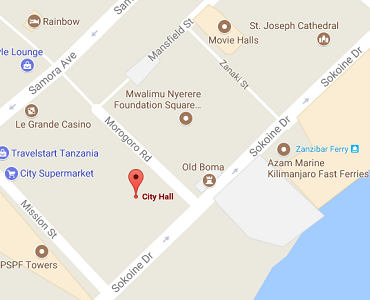Dar-es-Salaam is popularly known as the “HARBOUR (HAEVEN) of PEACE”, the name being originated from the Arabic word “Bandar-ul-Salaam” which means in Swahili “Bandari ya Salama”. Dar-es-Salaam was declared a Township in 1920 and in 1949 it was upgraded to a Municipality under the first appointed British Mayor Mr. Percy Everett. When Tanganyika became independent in 1961, Dar-es-Salaam Municipality was elevated to a City status and continued to be the Headquarters of the then Independent Tanganyika and later the United Republic of Tanzania. Dar-es Salaam remained a Capital City till 1970s when the Government announced the shift of Capital City to Dodoma and Dar-es-Salaam remaining a commercial City.
The City of Dar es Salaam is located between Latitudes 6.36 degrees and 7.0 degrees to the South of Equator and Longitudes 39.0 and 33.33 to the East of Greenwich. It is bounded by the Indian Ocean on the East and by the Coast Region on the other sides. The City experiences a modified type of equatorial climate. It is normally hot and humid throughout the year with an average temperature of 29ºC. The hottest season is from October to March during which temperatures may be up to 35ºC. It is relatively cool between May and August with temperature around 25ºC. There are two main rain seasons; a short rain season from October to December and a long rain season between March and May. The average rainfall is 1000mm (lowest 800mm and highest 1300 mm). The City is divided into three ecological zones, namely the upland zone, the middle plateau, and the low lands. The main natural vegetation includes coastal shrubs, Miombo woodland, coastal swamps and mangrove trees.
The Dar es Salaam City has a total surface area of 1,393 square kilometers, which is about 0.15% of the entire Tanzania Mainland’s area. According to the 2012 population census, the City had a population of 4,364,541 of which 2,125,786 (48.7%) are males and 2,238,755 (51.3%) are females. Figure 2 summarizes the City’s population trend from 67,227 in 1948 to 4,364,541 in 2012 (NBS, 2012). With the 5.6 annual population growth rate, population in Dar es Salaam is estimated to be 5,586,612 by 2017 and it is projected to 9.7 million by 2030 and 15.6 million by 2050.
Despite the Government’s decision to move its Capital City to Dodoma; Dar es Salaam remains the major City of Tanzania and the hub of commercial activities. It has more than 575 major industrial establishments, a Central Bank, Commercial Banks, Foreign exchange bureaus, Insurance companies and transportation networks. Administratively, Dar es Salaam has a regional administration headed by the Dar es Salaam Regional Commissioner. It also has a City Council administration headed by the Mayor of Dar es Salaam. The City has five (5) Municipal Councils and by their embedded administrative functions they form Municipals of the Dar-es Salaam Region. The 5 Municipals are: Temeke Municipal Council, Kinondoni Municipal Council, Ilala Municipal Council, Ubungo Municipal Council and Kigamboni Municipal Council.
The City governing body is the City Council, which comprises of 26 Councilors, with a representation of 4 Councilors from each Municipal Council. The City Director is the Chief Executive Officer who executes all day to day administrative duties.
According to the Local Government Act 1982, (Revised Edition 2002) The Council has the following responsibilities:-


1 BARABARA YA MOROGORO 11882 DAR ES SALAAM
Postal Address: S.L.P 20950
Telephone: 0738 378 386
Mobile: 0738 378 386
Email: info@dcc.go.tz
Copyright © 2017 Dar es Salaam City Council . All rights reserved.